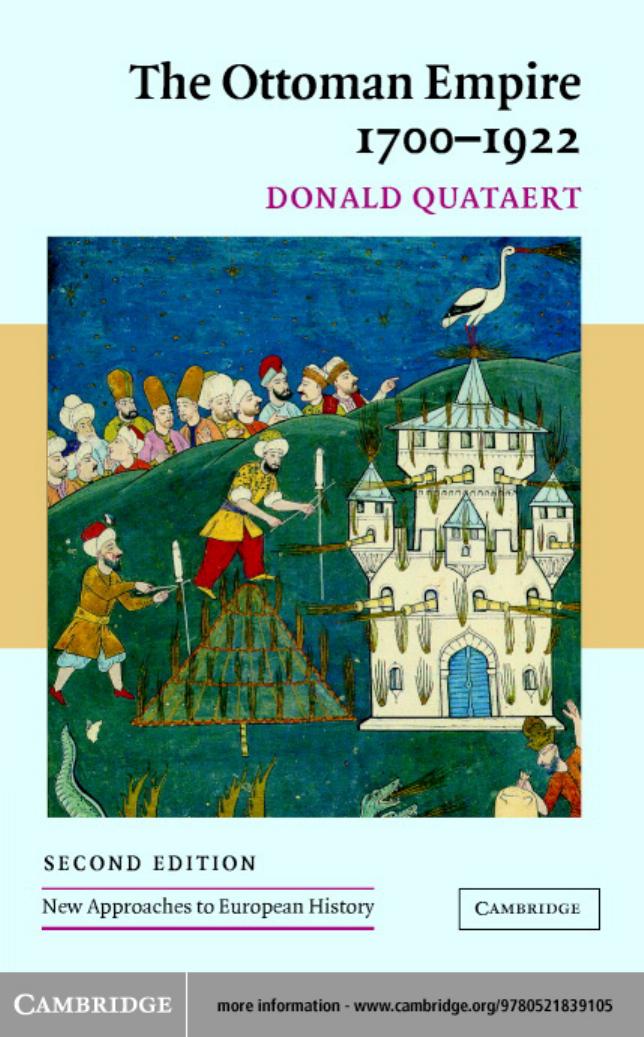The Ottoman Empire, 1700-1922 by Donald Quataert

Author:Donald Quataert [Quataert, Donald]
Language: eng
Format: epub, pdf
Tags: History, General, Europe, Middle East, Renaissance, Modern, Political Science, Social Science, Sociology
ISBN: 9780521839105
Google: OX3lsOrXJGcC
Publisher: CambridgeUP
Published: 2005-08-11T20:41:57+00:00
Aspects of Ottoman administration
The devÅirme method of recruiting administrators and soldiers â the âchild levyâ â was long gone by 1700 but deserves discussion here for the light it sheds on the stereotyping that remains all too prevalent in popular perceptions of the Ottoman past. The stereotype overemphasizes the importance of the devÅirme and asserts that Christian converts to Islam were responsible for Ottoman greatness. As most overgeneralizations, this stereotyping emerges out of some realities. During the fifteenth and sixteenth centuries, devÅirme conscripts indeed were an important source of state servants and many became grand viziers and other high administrators. Gradually, however, the devÅirme was abandoned. Sultan Osman II tried to abolish it in 1622, indicating that it was becoming obsolete and dysfunctional. His successor, Sultan Murat IV, suspended the levy and it essentially had disappeared from Ottoman life by the mid-seventeenth century. The stereotyping comes from the coincidence of this diminishing use of the levy with another fact, namely, that the empire was declining in military power during these same years.
In fact, there are several false assumptions present here: the first surrounds the role of changes in domestic political structures in the observable weakening of the Ottoman Empire after c. 1600. For many years, observers falsely concluded that the evolution of the domestic institutions, the shift in power away from the sultan, caused the weakening of the empire in the international struggle for power. Historians, however, now have concluded that domestic political structures in the Ottoman Empire were undergoing change between the sixteenth and the eighteenth centuries, a process that is better described as the evolution of Ottoman institutions into new forms. In their new forms, the institutions certainly differed from those of the past: sultans now merely reigned while viziers and pashas actually ran the state. But these differences in domestic institutions constituted a transformation, not a weakening, between the sixteenth and eighteenth centuries. The charges of weakness and decline stem from the international front where the Ottomans indeed were losing wars and territories. Internationally, the Ottoman system of 1750 was certainly less powerful than it had been in 1600; the relative international position of the empire had fallen quite sharply. Here is the real story of decline. Falling further and further behind Europe, the Ottomans shared a fate with the entire world but for Japan (and its rise of world power after 1853). The west (and some east and central) European states had become immeasurably stronger; the Ottoman Empire, which c. 1500 had been among the most powerful, fell to second-rank status during the eighteenth century. The transfer of power out of the sultanâs hands occurred at the same time as but did not cause this international decline.
The second false assumption revolves around the now abandoned notion that the source of Ottoman state strength had been the (converted) Christians running it. When the devÅirme faded, the argument went, so did the power of the state because Muslims and no longer the ex-Christians now were in charge. In
Download
The Ottoman Empire, 1700-1922 by Donald Quataert.pdf
This site does not store any files on its server. We only index and link to content provided by other sites. Please contact the content providers to delete copyright contents if any and email us, we'll remove relevant links or contents immediately.
| Bahrain | Egypt |
| Iran | Iraq |
| Israel & Palestine | Jordan |
| Kuwait | Lebanon |
| Oman | Qatar |
| Saudi Arabia | Syria |
| Turkey | United Arab Emirates |
| Yemen |
Empire of the Sikhs by Patwant Singh(23021)
The Wind in My Hair by Masih Alinejad(5056)
Rise and Kill First by Ronen Bergman(4739)
The Templars by Dan Jones(4656)
The Rape of Nanking by Iris Chang(4165)
12 Strong by Doug Stanton(3526)
Blood and Sand by Alex Von Tunzelmann(3164)
Babylon's Ark by Lawrence Anthony(2648)
The History of Jihad: From Muhammad to ISIS by Spencer Robert(2599)
No Room for Small Dreams by Shimon Peres(2343)
The Turkish Psychedelic Explosion by Daniel Spicer(2330)
Inside the Middle East by Avi Melamed(2325)
Gideon's Spies: The Secret History of the Mossad by Gordon Thomas(2319)
Arabs by Eugene Rogan(2279)
The First Muslim The Story of Muhammad by Lesley Hazleton(2245)
Come, Tell Me How You Live by Mallowan Agatha Christie(2228)
Bus on Jaffa Road by Mike Kelly(2123)
Kabul 1841-42: Battle Story by Edmund Yorke(2003)
1453 by Roger Crowley(1994)
